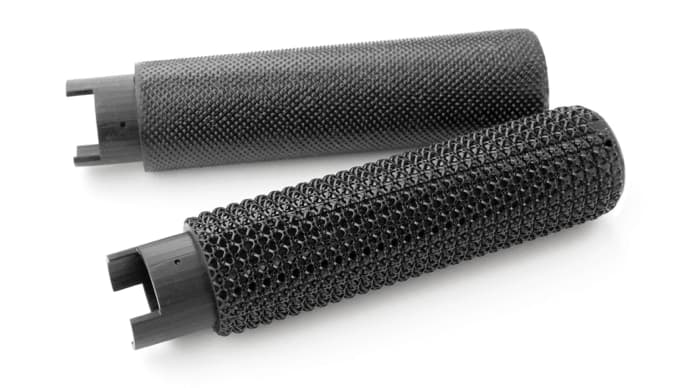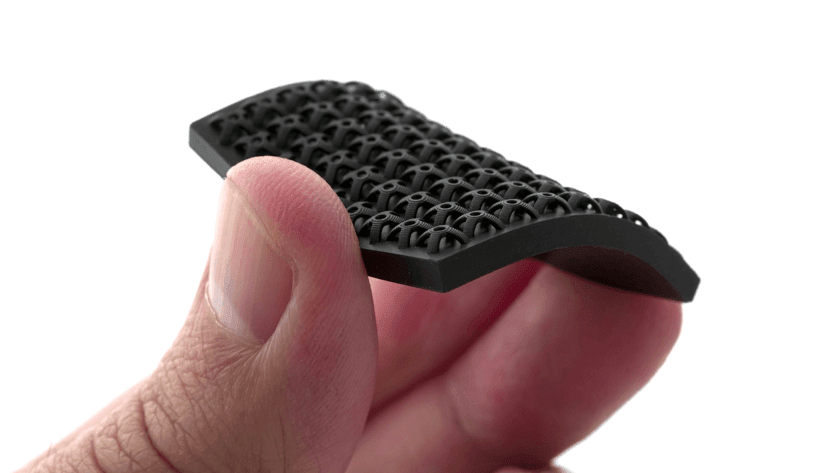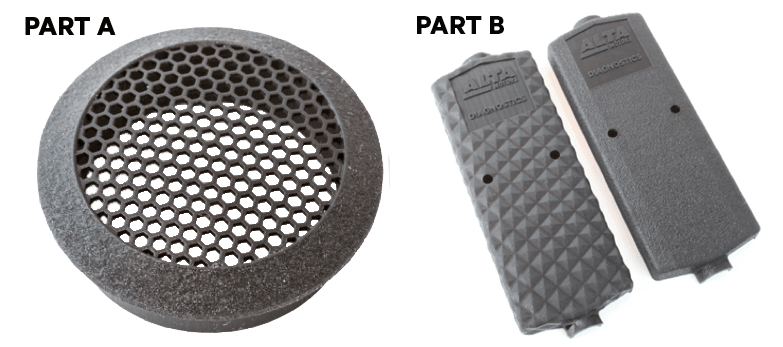We will highlight the three main challenges that product development teams face when manufacturing textured injection molded parts and how Carbon solves these challenges. Product development teams will appreciate the advantages of adopting Carbon’s end-to-end digital texturing approach, enabled by our Digital Light Synthesis™ technology. This is a paradigm shift, offering design freedom, quick design iterations, and a broad range of tunable Carbon textures.
CUSTOMER CHALLENGES AND CARBON’S SOLUTION
At Carbon, we partner with customers across industry verticals, ranging from consumer products and medical devices to industrial and automotive products. Our customers have faced three engineering and design challenges when applying textures to final production parts using traditional approaches such as injection molding. Carbon’s M Series printers, software capabilities, and materials are uniquely positioned to solve these texturing challenges, enabling our customers to create differentiated final parts.
CHALLENGE #1: TEXTURING CURVED SURFACES
Injection molding tool designers and die-makers have always found it challenging to consistently apply a texture on curved surfaces because traditional methods are fundamentally ill-suited to the task. Applying texture to a part or a product often requires costly and complex etching treatment to a mold or laborious post-processing on the part itself. Carbon’s technology solves this problem as our digital solution can apply textures on final parts during printing regardless of their geometry. With injection molding, tooling designed to impart consistent textures on curved surfaces is difficult to fabricate and is costly. Figure 1 highlights our ability to print textures on curved surfaces with excellent surface finish and a wide range of textures achievable.

Figure 1: Bicycle grips with two different textures digitally fabricated on curved surfaces using EPU 40 resin.
CHALLENGE #2: ACHIEVING UNMOLDABLE TEXTURES
Product development teams have historically struggled to achieve difficult-to-tool textures such as a shark skin-like pattern with an undercut. Such textures are typically considered unmoldable and, when attempted, result in high tooling costs, high post-production costs, and quality issues in final parts. Using Carbon’s proprietary software features and processes, customers have access to excellent surface finish and resolution on difficult-to-tool low-angle textures, as well as textures with undercuts. Carbon is pushing the limits of the role textures can play in product design, expanding textures from simple aesthetics to new capabilities driven by the engineering of complex geometries. These engineered functional surfaces (Figure 2) open the door to new applications in areas such as biomimicry, hydrophobicity, friction control, and flow control. Customers can work with their Carbon Technical Partners and explore how Digital Light Synthesis™ technology can help create differentiated products in the market.

Figure 2: Sample part showing complex undercut capability using Carbon’s technology to create functional textures.
CHALLENGE #3: ENABLING TEXTURES AT EVERY STAGE OF THE PRODUCT DEVELOPMENT CYCLE
With traditional manufacturing approaches, textures are typically added at the very end of the product development cycle once the final production method has been validated. This is a challenge for many customers, as it is not possible to physically evaluate the texture on the part before committing to costly final production; any iteration or modification after this step by stakeholders and designers requires additional product development cycles, such as costly retooling and redesign.
Carbon solves this problem by helping designers experience and see textures on parts during every stage of the product development cycle. With Carbon, quick iterations and unmatched print speeds enable designers and engineers to collaborate in real-time instead of waiting for tooling and associated delays with traditional approaches.
ECONOMIC BENEFITS
In addition to design and product development benefits, Carbon’s technology offers economic benefits as well:
- Designers can now experience how a part looks and feels from the beginning, and engineering managers should expect a reduction in the number of rework requests on textured parts when using Carbon’s technology. Retooling with conventional manufacturing typically results in expensive tooling costs and potential delays in time-to-market for products.
- In comparison to traditional texturing approaches, textures with Carbon are essentially free, as engineers 3D print textures directly on final production parts with limited post-processing impact. Carbon’s texturing process, as part of an end-to-end digital workflow, is inherently tunable and controllable on any surface. This reduction in process complexity results in improved time-to-market and reduced labor costs for post-processing.
CARBON TEXTURE SOLUTION: TWO FINAL PRODUCTION PARTS
Customers are actively working with Carbon Technical Partners and production partners to apply textures on final production parts. Figure 3 shows two examples.
- Part A is an aftermarket Soundz tweeter grill housing. It was critical to match the 3D printed tweeter grill texture to the original speaker assembly for seamless integration. The part was printed using RPU 70 resin with help from Primary Manufacturing, a Carbon production partner.
- Part B is a diagnostic housing developed by Alta Motors using RPU 70 resin. The texture in this version demonstrates both mechanical performance as well as aesthetic details.

Figure 3: Two final production parts created using Carbon’s texture solution. Part A is an aftermarket Soundz tweeter housing grill, and Part B is a diagnostic housing for Alta Motors.
CONCLUSIONS
Textures on parts and products have always appealed to the human tactile and aesthetic senses. At Carbon, we are making it easier for designers and engineers to access a broad range of Carbon textures on 3D printed parts. Benefits, such as textures on curved surfaces, unmoldable textures, and the ability for product teams to experience textures throughout the entire product development lifecycle are significant breakthroughs.
For designers looking to take advantage of Carbon’s breakthrough texture capabilities, contact us or email our sales team at sales@carbon3d.com.
Please note that Carbon’s texture capabilities described in this solution brief are currently available by working with a Carbon Technical Partner who can help identify and explore how textures can differentiate your products in the marketplace. Carbon Technical Partners are a dedicated resource provided by Carbon as part of the standard subscription agreement.
¹Feeling Small: Exploring the Tactile Perception Limits (https://www.nature.com/articles/srep02617)